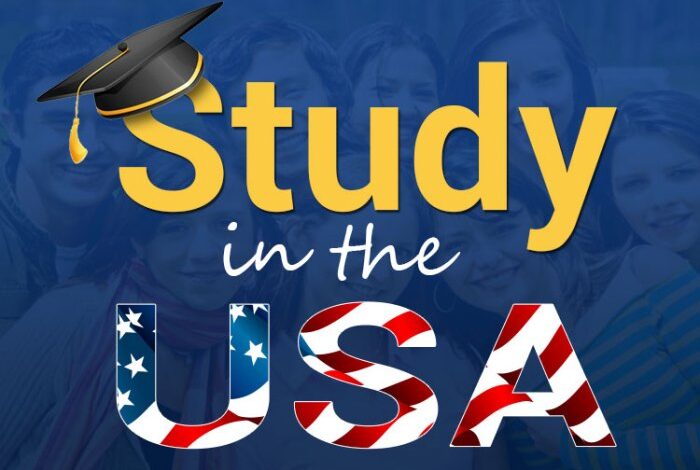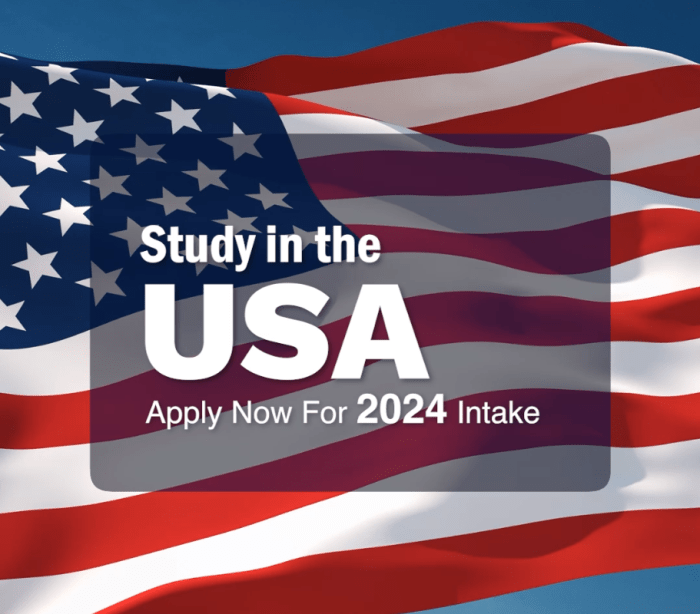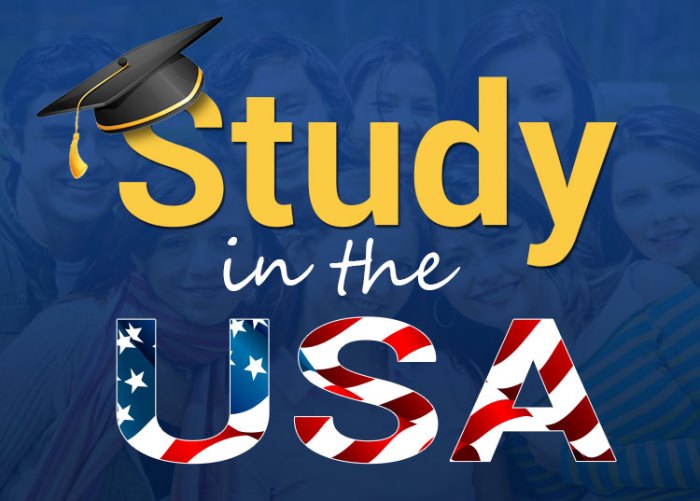
Study in the USA: Embark on an academic adventure in the land of opportunity! This comprehensive guide dives deep into the world of studying abroad in the US, covering everything from program types and costs to visa requirements, living experiences, and career prospects. We’ll explore the diverse academic landscape, the financial realities, and the essential steps to successfully navigate the process.
Whether you’re a prospective undergraduate, graduate student, or professional aiming for advanced degrees, this guide provides the essential information to make informed decisions. From detailed program comparisons to helpful tips on navigating the application process, we aim to equip you with the knowledge you need to pursue your academic goals in the US.
Types of Studies in the USA
The United States boasts a diverse and comprehensive higher education system, offering a wide array of academic programs to cater to various interests and career aspirations. From traditional undergraduate degrees to specialized graduate and professional programs, students have a plethora of options to pursue their academic goals. This exploration delves into the different types of studies available, their nuances, and the processes involved in gaining admission.
Academic Program Types
The American higher education system encompasses various program types, each with its own set of requirements and expectations. These types include undergraduate, graduate, and professional programs. Undergraduate programs typically lead to bachelor’s degrees, while graduate programs lead to master’s and doctoral degrees. Professional programs, such as law and medicine, often lead to specific professional licenses or certifications.
Degree Types and Requirements
Different degree types vary significantly in their duration and requirements. A bachelor’s degree typically takes four years of full-time study, while a master’s degree can take one to two years. Doctoral degrees, like PhDs, require significant research and can take several years, often extending beyond five years. Specific requirements include coursework, research, and examinations, varying by field.
For example, a Bachelor of Science in Engineering will have different course requirements than a Bachelor of Arts in English.
Admission Processes
Admission processes for different study levels also differ. Undergraduate admission often considers high school transcripts, standardized test scores (like the SAT or ACT), and personal essays. Graduate programs typically require a bachelor’s degree, strong academic records, letters of recommendation, and a compelling statement of purpose. Professional programs have unique and often more stringent admission requirements, frequently including specific prerequisites, interviews, and performance evaluations.
The complexity of the admission process reflects the diverse academic rigor of the programs.
Study Options
Students can choose various study options, including full-time, part-time, and online. Full-time study immerses students in their academic pursuits, allowing for a more comprehensive learning experience. Part-time study offers flexibility, allowing students to balance academics with other commitments. Online study provides significant flexibility, allowing for learning from anywhere in the world, but requires self-discipline and effective time management.
Examples of Specific Programs
Numerous specific programs are available across various disciplines. In engineering, students can pursue Bachelor of Science in Mechanical Engineering, or Master of Science in Aerospace Engineering. In medicine, a Doctor of Medicine (MD) is the common path, while in business, a Master of Business Administration (MBA) is a popular choice.
Program Overview Table
| Program Type | Degree | Duration | Admission Requirements |
|---|---|---|---|
| Undergraduate | Bachelor of Arts/Science | 4 years (full-time) | High school transcript, standardized test scores (SAT/ACT), personal essay |
| Graduate | Master of Science/Arts | 1-2 years (full-time) | Bachelor’s degree, strong academic record, letters of recommendation, statement of purpose |
| Professional | Doctor of Medicine (MD), Juris Doctor (JD) | Variable (often longer than graduate) | Specific prerequisites, interviews, performance evaluations |
Cost of Studying: Study In The Usa
Studying in the USA can be an enriching experience, but it also comes with significant financial responsibilities. Understanding the costs associated with different aspects of your education is crucial for effective planning and budgeting. This section will provide a comprehensive overview of expenses, influencing factors, and financial aid options for international students.
Thinking about studying in the USA? It’s a fantastic opportunity, offering a wide range of programs and experiences. Recent breakthroughs in technology, like the development of room-temp masers, demonstrating how quickly innovation is happening , highlight the cutting-edge research environment you might find there. So, if you’re keen on pursuing a STEM degree or other specializations, the USA offers incredible opportunities for growth and discovery.
Tuition Fees, Study in the usa
Tuition fees vary significantly depending on the institution and the specific program. Public universities generally have lower tuition rates than private institutions. The program’s level (undergraduate, graduate, or professional) also impacts the cost. Specialized programs, such as medicine or law, tend to have higher tuition fees. The cost is often dependent on the number of credit hours taken per semester.
It is advisable to research the specific tuition fees for the chosen program and institution.
Accommodation Costs
Accommodation expenses are another major component of the cost of studying in the USA. The type of accommodation, whether on-campus or off-campus housing, significantly affects the price. Off-campus apartments or houses usually offer more space and flexibility, but can be more expensive than on-campus options. Living in urban areas often comes with higher costs compared to smaller towns or suburbs.
Factors like the size of the living space, amenities, and proximity to the university play a role in determining the cost. Budgeting for utilities, such as electricity, gas, and internet, is also essential.
Dreaming of studying in the USA? It’s a fantastic opportunity, but with things like the recent news of Google axing its health service due to a lack of user engagement ( google axes health service due to feeble response ), it’s worth remembering that even huge tech companies can face challenges. Ultimately, though, the US still offers a wealth of educational resources and opportunities for students from around the world.
Living Expenses
Living expenses in the USA cover a wide range of needs, including food, transportation, and personal expenses. The cost of living varies considerably depending on the location. Urban centers like New York or San Francisco have higher living expenses compared to smaller towns. Groceries, entertainment, and transportation costs can vary depending on individual spending habits and preferences.
Factors Influencing Cost
Several factors influence the overall cost of studying in the USA. Location is a key factor, as the cost of living varies dramatically across different states and cities. The type of program, such as a master’s degree in engineering versus a bachelor’s degree in liberal arts, also impacts the overall cost. The choice of accommodation (on-campus, off-campus, or shared housing) and the lifestyle preferences of the student will influence the overall cost of living.
Average Costs
Providing precise average costs for different program types and locations is difficult due to the wide variation in factors. However, general estimations are available. Undergraduate programs at public universities in the Midwest might have tuition fees around $10,000-$20,000 per year. Master’s programs in high-demand fields at private institutions in major cities could cost upwards of $30,000-$50,000 per year.
Dreaming of studying in the USA? While the allure of American education is strong, the tech world’s relentless pursuit of innovation, as seen in articles like ” tech hungry crazy ants not so fast “, might not always translate to a smooth path. Ultimately, the US still offers a fantastic opportunity for academic growth and career development.
Living expenses in these areas might range from $1,500-$3,000 per month. It’s crucial to consult the specific institution’s website for the most up-to-date and accurate figures.
Financial Aid Options for International Students
International students can access various financial aid options to mitigate the costs of studying in the USA. Scholarships, grants, and loans are available from both governmental and private sources. The application process for these options typically involves submitting academic transcripts, financial statements, and letters of recommendation.
Financial Aid Application Procedures
Applying for financial aid often involves a multi-step process. Students need to research available aid options, gather necessary documents, and submit applications to the appropriate institutions by specified deadlines. The application process for each financial aid source will differ, so it’s essential to carefully review the instructions and requirements for each opportunity. Some scholarships might require specific academic achievements, while others might consider extracurricular activities or personal circumstances.
Financial Aid Example Table
| Expense Category | Estimated Cost | Funding Options |
|---|---|---|
| Tuition Fees | $20,000 – $50,000 (per year) | Scholarships, grants, loans, student employment |
| Accommodation | $800 – $2,000 (per month) | Scholarships, grants, loans, student employment, university housing |
| Living Expenses | $1,000 – $2,500 (per month) | Scholarships, grants, loans, part-time jobs |
Visa and Immigration

Navigating the US immigration system for international students can feel daunting. Understanding the visa process is crucial for a smooth transition and successful academic journey. This section delves into the specifics of student visas, highlighting requirements, application procedures, and essential documentation.The US offers various student visa options tailored to different study programs and durations. Each visa type comes with specific eligibility criteria and requirements.
Thorough preparation and adherence to regulations are vital for a positive experience.
Visa Requirements for International Students
The US government requires international students to obtain a student visa (F-1 or M-1) before entering the country. These visas permit students to pursue academic studies or vocational training, respectively. Each visa type has unique eligibility criteria. Meeting these requirements ensures a legally compliant stay during the academic program.
Types of Student Visas
The F-1 visa is the most common type, allowing students to pursue academic studies at accredited institutions. The M-1 visa is designed for students pursuing vocational or non-academic programs. Both options require careful consideration of the specific program and institutional accreditation.
- F-1 Visa: This visa is for academic studies at accredited institutions. It requires demonstrating sufficient financial resources to support oneself during the study period.
- M-1 Visa: This visa allows participation in non-academic vocational training programs. This includes technical, professional, or career-focused programs.
Steps Involved in the Visa Application Process
The visa application process typically involves several key steps. Careful adherence to these steps ensures a smooth and efficient process.
- Complete the DS-160 Form: This online form gathers personal and academic details. Accurate and complete information is essential for the application’s success.
- Schedule a Visa Interview: The US embassy or consulate will schedule an interview. This is a crucial step where the visa officer assesses the applicant’s eligibility.
- Gather Required Documents: Proper documentation is paramount for a successful application. This includes proof of enrollment, financial support, and travel history.
- Attend the Visa Interview: Be prepared to answer questions about your educational goals, financial stability, and intentions for returning to your home country.
- Wait for the Visa Decision: The visa officer will review the application and make a decision. Processing times can vary.
Documentation Needed for Visa Applications
A comprehensive package of documents is necessary for a successful visa application. This includes proof of enrollment, financial resources, and travel history.
- Proof of Enrollment: Official acceptance letter from the US institution is required. This shows that the student is admitted to the program and course.
- Financial Resources: Documents demonstrating sufficient funds to cover tuition, living expenses, and travel costs are essential. This includes bank statements and financial aid documentation.
- Passport and Other Supporting Documents: A valid passport with at least six months of validity beyond the intended stay in the US. Additional documents, such as transcripts, certificates, and letters of recommendation, may be required.
Importance of Meeting Deadlines for Visa Applications
Meeting application deadlines is crucial. Delays can lead to missed opportunities to study in the US. Planning ahead is vital to ensure timely submission of required documents.
Visa Types, Required Documents, and Processing Times
| Visa Type | Required Documents | Processing Time (Estimate) |
|---|---|---|
| F-1 (Academic) | DS-160 form, I-20 form, passport, financial documents, transcripts, proof of health insurance | 2-4 weeks (can vary) |
| M-1 (Vocational) | DS-160 form, I-20 form, passport, financial documents, transcripts, proof of health insurance | 2-4 weeks (can vary) |
Living in the USA

Embarking on a study journey in the USA opens doors to diverse experiences. Beyond the academic pursuits, the vibrant tapestry of American life awaits. Understanding the nuances of living environments, cultural variations, and practical considerations is crucial for a smooth transition. This exploration delves into the multifaceted aspects of everyday life in the US, providing insights into accommodation, transportation, and social engagement.The US boasts a rich diversity of landscapes and lifestyles, from bustling cityscapes to serene rural areas.
This diversity reflects in the unique cultural experiences offered across states and cities. International students will encounter a variety of social norms, customs, and communication styles. Navigating these differences will be key to integrating successfully.
Living Environments Across Cities and States
American cities and states offer contrasting living environments. Urban centers like New York City, Chicago, and Los Angeles present dynamic, fast-paced lifestyles, with diverse populations and vibrant cultural scenes. Conversely, smaller cities and suburban areas often provide a more relaxed atmosphere, with a greater emphasis on community and family. Rural areas may offer tranquility and access to nature, though daily amenities may differ from urban settings.
The differences in pace, density, and the availability of services significantly influence the daily experience.
Cultural Aspects and Regional Differences
Regional variations in culture and customs are pronounced. The South, for instance, often exhibits a distinct social etiquette and cultural norms. The Midwest might be known for its friendliness and emphasis on community. The West Coast often embraces a more liberal and laid-back lifestyle. These differences are visible in social interactions, communication styles, and even the food and music enjoyed in various regions.
Finding Suitable Accommodation for Students
Finding suitable accommodation is an essential step for international students. Options range from university-owned housing to apartments and shared houses. Online platforms and real estate agencies are helpful resources for locating suitable options. Students should carefully consider factors like location, cost, safety, and amenities when making their decisions. Student housing often comes with a sense of community and convenience, while apartments may offer more independence.
Transportation Options in Major Cities
Transportation options vary widely across major cities. Public transportation systems, including subways, buses, and light rail, are prevalent in large metropolitan areas like New York, Chicago, and Boston. Ride-sharing services like Uber and Lyft are also popular, providing flexibility and convenience. Driving a car can be necessary in certain areas, and this may be a factor in accommodation choices.
Social Activities for International Students
International students can engage in a wide array of social activities. University-sponsored events, cultural clubs, and social groups offer opportunities to connect with peers and build a network. Participating in extracurricular activities, attending local events, and exploring the city’s diverse offerings are important ways to integrate into the local community. Social media platforms and online forums can be helpful in finding and joining groups.
Comparison of Living Costs, Cultural Norms, and Social Activities
| City | Living Costs (Estimated) | Cultural Norms | Social Activities |
|---|---|---|---|
| New York City | High | Fast-paced, diverse, emphasis on individuality | Numerous cultural events, concerts, museums, diverse social groups |
| Los Angeles | Moderate to High | Relaxed, diverse, emphasis on entertainment | Outdoor activities, movie premieres, concerts, hiking |
| Chicago | Moderate | Friendly, diverse, emphasis on community | Sporting events, cultural festivals, theatre performances |
| Austin | Moderate | Vibrant, creative, emphasis on music and technology | Live music venues, tech events, outdoor festivals |
Note: Living costs are estimates and may vary based on lifestyle choices. Cultural norms are generalizations and individual experiences may differ. Social activities are examples and availability may vary.
Academic Resources
Navigating a new academic environment, especially as an international student, can be challenging. Understanding the academic support systems available can alleviate many of these concerns and facilitate a smoother transition. This section details the resources available to help international students succeed in their studies and beyond.
Academic Support Systems
A comprehensive network of support systems is designed to aid international students. These systems include tutoring, writing centers, and academic advising, each playing a vital role in student success. These services provide personalized attention, tailored feedback, and guidance to help students overcome academic hurdles.
- Tutoring: Tutoring services offer individualized support to students struggling with specific subjects. Tutors provide personalized guidance, helping students grasp challenging concepts and improve their understanding of course material. They can offer targeted practice and strategies for learning effectively. Many tutoring programs employ experienced faculty and graduate students, ensuring high-quality instruction.
- Writing Centers: Writing centers are invaluable resources for students needing help with their academic writing. These centers offer workshops, one-on-one consultations, and feedback on assignments, enhancing the quality of student work. They assist students with various aspects of the writing process, from brainstorming and outlining to editing and proofreading. This support is crucial for international students adapting to different academic writing styles and expectations.
- Academic Advising: Academic advisors provide personalized guidance on course selection, degree planning, and academic progress. They offer valuable insights into the academic requirements and expectations of the university. This personalized support is crucial for international students unfamiliar with the American academic system. This often includes information about specific academic regulations and policies.
Accessing Academic Resources
The process for accessing these resources varies slightly depending on the institution, but generally involves registering with the specific support center. Often, students can find the required information on the university website, including contact details and appointment scheduling procedures. Most universities have online portals for scheduling appointments, accessing support materials, and keeping track of progress.
Examples of Successful Student Support Programs
Many universities have established highly successful student support programs. For instance, the University of California, Berkeley, has a robust tutoring program with a large network of trained tutors. Similarly, Stanford University’s writing center offers extensive resources and workshops for improving writing skills. These programs demonstrate the commitment to student success and the value of these support services.
Career Development and Job Searching
Career development resources are essential for students seeking employment opportunities after graduation. These resources typically include workshops, seminars, and networking opportunities. They also provide assistance with resume writing, interviewing skills, and job search strategies. Many universities have career centers that offer dedicated services for international students, helping them navigate the job market in the USA.
University Libraries and Services
University libraries are vital academic hubs. They offer access to a vast collection of books, journals, and online databases. These resources are essential for research, course preparation, and academic success. Furthermore, many libraries provide specialized services for international students, including language support and assistance with research methodologies. Librarians are often trained to provide assistance with navigating the library resources, making them invaluable guides for research.
Table of Academic Resources
| Resource | Location | Contact Information |
|---|---|---|
| Tutoring Services | Academic Services Building, Room 201 | (123) 456-7890, [email protected] |
| Writing Center | Student Union, 3rd Floor | (123) 456-7891, [email protected] |
| Academic Advising | Student Services Center, Room 102 | (123) 456-7892, [email protected] |
Research Opportunities
Research opportunities are a crucial aspect of the student experience in the USA, offering valuable experience for career development and future endeavors. International students can actively participate in various research projects, gaining hands-on experience in their field of study. These experiences often lead to publications, presentations at conferences, and letters of recommendation that significantly enhance their applications for graduate school and future employment.Research positions are typically offered by professors and research labs within universities.
International students, with their diverse backgrounds and perspectives, bring unique contributions to research teams. Successfully navigating the application process and effectively engaging with the research environment is key to making the most of these opportunities.
Research Opportunities for International Students
International students can leverage numerous research opportunities within universities. These include working on faculty-led projects, collaborating with research labs, and contributing to ongoing studies. The process typically involves identifying professors whose research aligns with the student’s interests, and then proactively contacting them to inquire about potential research opportunities.
Procedures for Applying for Research Positions
The application process often involves a combination of formal and informal approaches. Students should meticulously review the specific requirements of each position, which might include a CV, cover letter, transcripts, and letters of recommendation. Direct contact with the professor or research advisor is essential, allowing students to articulate their research interests and qualifications. Participating in seminars or attending research presentations can provide further insights into specific research projects and potential opportunities.
Examples of Research Projects Undertaken by International Students
Many international students have successfully contributed to diverse research projects. For instance, students in engineering programs have contributed to innovative design projects, while those in the social sciences have participated in surveys and data analysis. In the sciences, students have assisted with experiments, data collection, and analysis. These projects vary in scope and complexity, but all provide valuable experience and development opportunities.
Importance of Research Experience for Career Development
Research experience provides a unique opportunity to develop practical skills that are highly sought after by employers. It allows students to refine their analytical abilities, problem-solving skills, and time management techniques. Furthermore, it fosters critical thinking, collaboration, and communication skills, all crucial for success in any professional field. The experience also helps in developing a strong understanding of the scientific or academic process.
Role of Mentors and Supervisors in Research Projects
Mentors and supervisors play a crucial role in guiding and supporting international students in their research projects. They offer guidance, provide feedback, and facilitate the learning process. Mentors often help students navigate the intricacies of research methodology, ensuring the projects remain on track and contribute meaningful insights.
Table of Research Areas, Professors, and Application Requirements
| Research Area | Associated Professor | Application Requirements |
|---|---|---|
| Biomedical Engineering | Dr. Emily Carter | CV, cover letter, transcript, letter of recommendation from a previous professor, brief research proposal |
| Social Sciences | Dr. David Lee | CV, cover letter, transcript, letter of recommendation from a previous professor, brief description of research interests |
| Environmental Science | Dr. Maria Rodriguez | CV, cover letter, transcript, letter of recommendation from a previous professor, a brief summary of past research experiences and relevant skills |
Wrap-Up
In conclusion, studying in the USA offers a wealth of opportunities, but meticulous planning is key. This guide has provided a thorough overview of the various aspects, from academic programs and costs to visas, living situations, and career prospects. Remember to thoroughly research your desired program and location, understand the financial implications, and carefully follow the visa application procedures.
With careful planning, you can turn your dream of studying in the USA into a reality!

